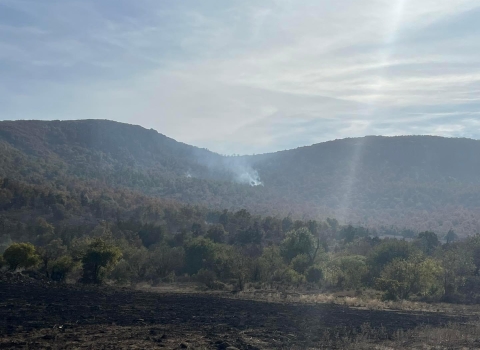The U.S. Fish and Wildlife Service has completed 90-day findings on petitions to list three species under the Endangered Species Act (ESA). Based on our review, the Service finds that the petitions to list the thick-leaf bladderpod and variable cuckoo bumble bee present substantial information that the petitioned actions may be warranted, and we will initiate status reviews for these species.
We find that the petition to recognize the Texas population of the ocelot as a distinct population segment (DPS) and to list that DPS does not present substantial information that this action may be warranted. As a result, the Service will not be taking further action on it.
The ocelot is a medium-sized cat, measuring up to three feet in length and is covered with irregular-shaped rosettes and spots that run the length of its body. Ocelots are solitary hunters, feeding on rodents, rabbits, reptiles and birds. Ocelots were listed as endangered under the ESA in 1972 range-wide, including both U.S. and foreign populations. The Texas population has been the target of decades of active recovery efforts and this decision will not alter ESA status or protections for ocelots in the U.S. This population encompasses a minor portion of the species’ range that stretches into Central and South America. In reviewing the information in the petition, we found that the Texas ocelot population does not meet the required significance element to be considered as a DPS.
The variable cuckoo was once found in 47 states and is currently found in 35 states, as well as Ontario, Canada and Mexico. The Service found that the petitioners presented credible evidence that the petitioned action may be warranted due to the loss of the host species, the American bumble bee. Cuckoo bumble bees do not produce workers of their own but instead female cuckoo bumble bees take over colonies of a host bumble bee. Its host workers then gather pollen and nectar for the cuckoo bumble bee’s larvae. Female variable cuckoo bumble bees no longer have the specialized hairs to collect pollen on their own and cannot survive or reproduce without the American bumble bee host. In 2021, the Service determined the American bumble bee may be warranted for listing under the ESA and would move forward with a full status review of the species.
The thick-leaf bladderpod is a small, yellow-flowered vascular plant known from the Pryor Mountain Desert in Carbon County in Montana and Big Horn County in Wyoming. The primary threat is a gypsum exploration project proposed within the largest subpopulation. Mining exploration activities may result in unavoidable impacts to the species through direct mortality, disturbance, invasive species invasive species
An invasive species is any plant or animal that has spread or been introduced into a new area where they are, or could, cause harm to the environment, economy, or human, animal, or plant health. Their unwelcome presence can destroy ecosystems and cost millions of dollars.
Learn more about invasive species introduction, and upgraded access roads. The Service will evaluate all potential threats during a scientifically rigorous 12-month status review.
The ESA allows citizens to petition the Service to add species to the ESA list, remove species from the list, and to reclassify species already on the list. To the maximum extent possible, the Service issues a finding on a petition within 90 days of the petition’s receipt.
Substantial 90-day findings represent a relatively low bar, requiring only that the petitioner provide information that the petitioned action may be warranted. The next steps involve in-depth status reviews and analyses using the best available science and information to arrive at a 12-month finding. The public can play an important role by sharing relevant information with the Service.
The Federal Register docket numbers and links for the substantial petition findings in this batch are:
Species | Range | Docket Number | Docket link |
Texas population of ocelot | TX | FWS–R2–ES–2021–0119 | |
Variable cuckoo bumble bee | AL, AZ, AR, CA, CO, DE, FL, GA, IL, IN, IA, KS, KY, LA, MD, MI, MS, MO, MT, NE, NV, NJ, NM, NY, NC, OH, OK, OR, SC, SD, TN, TX, PA, VA, WV; Canada (Ontario); Mexico | FWS–R3–ES–2021–0118 | |
Thick-leaf bladderpod | MT, WY | FWS–R6–ES–2021–0117 |
The notice for the above findings will be available in the Federal Register Reading Room on February 7, 2022 at https://www.federalregister.gov/public-inspection on the 2021 Notices link under Endangered and Threatened Wildlife and Plants.
For more information on the ESA listing process, including 90-day findings and status reviews, please go to Listing Species as Threatened or Endangered.


